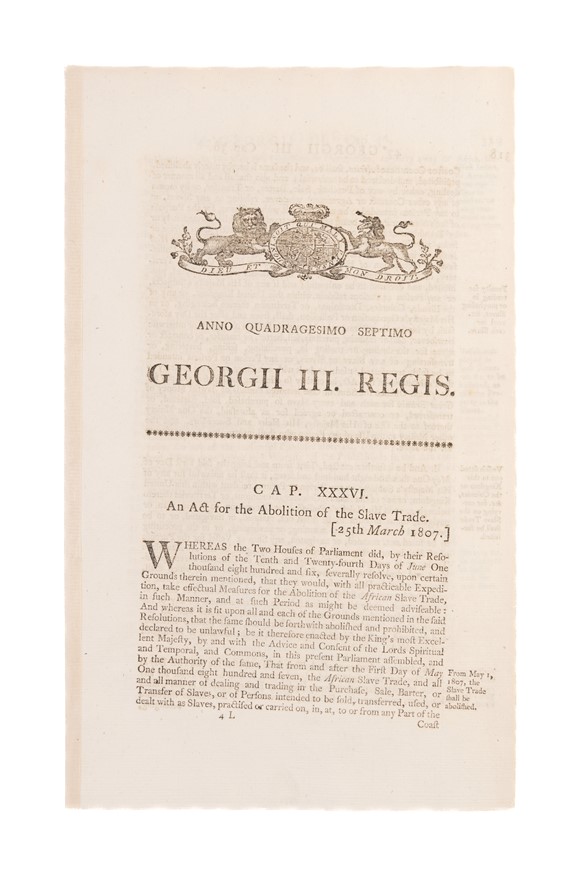An Act for the Abolition of the Slave Trade.
WILBERFORCE WIlliam. (1807.)
£7500.00 [First Edition]
Please contact us in advance if you would like to view this book at our Curzon Street shop.
THE 1807 ABOLITION ACT
First edition. Small folio. Removed from a volume with a paper spine. A crisp copy with paper watermarked 1803. [317]-326pp. London, George Eyre and Andrew Strahan,
"That from and after the First Day of May One thousand eight hundred and seven, the African Slave Trade, and all manner of dealing and trading in the Purchase, Sale, Barter, or Transfer of Slaves, or of Persons intended to be sold, transferred, used, or dealt with as Slaves, practised or carried on, in, at, to, or from any Part of the Coast or Countries of Africa, shall be, and the same is hereby utterly abolished, prohibited, and declared to be unlawful ..."
The long path to the abolition of the slave trade began with Quakers in 1776 who banned themselves from any act of enslavement. The movement gathered momentum in the 1780s with the likes of Thomas Clarkson, William Wilberforce, Granville Sharp, Hannah More, Josiah Wedgwood, and the publisher James Phillips. A wealth of abolitionist material began to appear in the press, aided by Clarkson Plan of the Slave Ship Brooks and Wedgwood's famous image Am I not a Man and a Brother? which became an emblem for the movement.
Thomas Clarkson spent years compiling evidence, interviewing nearly 20,000 sailors in Liverpool and Bristol. In 1787, Wilberforce committed to raising an abolition bill before the House of Commons and committee hearings began in 1789. After two years, there "were nearly 1,700 pages of House of Commons testimony, on top of the hefty 850-page volume from the Privy Council hearings of several years earlier, filled with eyewitness accounts, tables, and excerpts from slave laws of different colonies, some of them in French" (Hochschild). Wilberforce and his colleagues edited this material down into what became one of the key documents in the abolition process: An Abstract of the Evidence delivered before a Select Committee ... (London, 1791). It included a plan of the slave ship Brooks, and a map of Africa.
Wilberforce tabled further motions in 1798 and 1799, both of which were defeated. However, a 1799 act to reduce the overcrowding of ships was passed. In 1804, believing the political tide was turning, he tabled a bill for the abolition of the slave trade which passed through the Commons but not the House of Lords. In January 1807, Wilberforce published his Letter on the Abolition of the Slave Trade which "consolidated and restated the formidable array of evidence and argumentation against the trade that Wilberforce had developed over the previous two decades" (ODNB). It set the stage for "Grenville's introduction of an Abolition Bill in the Lords. When it had passed the upper house by unexpectedly large majorities, Viscount Howick (Charles Grey) moved its second reading in the Commons on 23 February. Wilberforce, though, was the real hero of the evening, as it became clear that this phase of his labours was at last coming to a triumphant end. Eloquent tributes were made to his efforts, and the bill passed by 283 votes to 16. It received the royal assent on 25 March" (ibid).
The job was only half finished. As the wording makes clear, while this landmark act abolished the African slave trade, enslavement was still legal and practised throughout the English colonies until the 1833 Emancipation Act was passed.
Hochschild, A., Bury the Chains (Macmillan, 2005), p.189.
.
Stock Code: 246054




